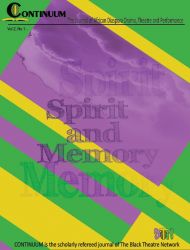Staging Migrations Toward an American West: From Ida B. Wells to Rhodessa Jones
By Marta Effinger-Crichlow. Boulder: University of Colorado Press, 2014; 264 pp.; illustrations. $34.95 cloth; $27.95 e-book.
With exhaustive scholarly and archival research, site visits, personal interviews, and the establishing of an archive of narratives, Marta Effinger-Crichlow’s Staging Migrations Toward an American West examines how Black women’s on- and off-stage performances—as part of their western migrations—shape tales of personal and sociopolitical journeys toward freedom. She defines migration both literally and figuratively: she traces the physical geographic paths of African American women through and into the West, while simultaneously illuminating their more subtle personal journeys towards recognition and representation.
For Effinger-Crichlow, migration is seen “not only as a physical process but as a series of symbolic, internal journeys within confined and unconfined spaces” (4). She applies her definition to the lives, migrations, and actions of social and political activist Ida B. Wells; classical singer, performer, and producer Sissieretta “Black Patti” Jones; multiple Black female World War II defense industry workers; and performance artist and prison-performance pioneer Rhodessa Jones.
With one chapter devoted to each of these four surprisingly interdependent case studies, Effinger-Crichlow features the myriad strategies African American women have used to navigate migration into the American West. In doing so, she also reveals the ways in which African American women perform their ideals of freedom, assert their places in society, and achieve levels of social and political freedoms. Her text is loosely tied together with selections and quotations from contemporary African American playwright Pearl Cleage’s Flyin’ West, a play which itself details the migration of nineteenth-century Black women as they attempt to find ownership and freedom on the western frontier. Like the women in Effinger-Crichlow’s case studies in Staging Migrations Toward an American West, Cleage’s women find a home in the West, and both figuratively and physically assert themselves on society as free Black women.
From the first chapter, “Tell My People to Go West,” Effinger-Crichlow frames her argument that migration is more than simple geographical movement through Ida B. Wells’s public performances of everyday life. As a Black female journalist, educator, and activist, Wells used the written word to challenge inequity and injustice while rallying African Americans in the South to unite in solidarity around many significant issues. Wells’s performances toward sociopolitical freedoms stemmed from her deep understanding (and use) of the power of the disseminated written word. Effinger-Crichlow craftily connects Wells’s movement and development of Black collective consciousness to her use of the pulpit to stage literal migrations with a special emphasis on mass movement out of Memphis. Through Wells’s life and journey, Effinger-Crichlow proves that Black freedom and mobility are inextricable.
In “I’d Go [Wherever] They Said ‘Show,’” Effinger-Crichlow explores how classical Black vocalist Sissieretta Joyner Jones used the stage as an opportunity for movement beyond domesticity in the Jim Crow era for both herself and her Black musical comedy troupe, the Black Patti Troubadours. The author describes how Jones and other Black female troupe performers, as respected and popular Black musical theatre artists, negotiated intersections of mobility and migration. While focusing on the exceptional act of Jones’s deployment of a private railway car (the “Black Patti, America’s Finest Show Car”), Effinger-Crichlow celebrates how the Black Patti Troubadours commanded social and physical space for Black women in the West, particularly in the new urban economy of Denver, Colorado. These women’s newfound freedoms of mobility and propriety combined, enabling Jones to provoke constructed conversations of gender, race, and class. Also worth noting is Effinger-Crichlow’s attention to the Black Patti Troubadours’ means of both challenging and reinforcing racially oppressive identities in popular performance through the dichotomy of their performances on and off the stage.
With “Wherever the Opportunity Was Goin’ to Be I’d a Been Gone,” Effinger-Crichlow reveals the stories and experiences of Black female migrants who moved to California’s Bay Area between 1940 and 1945 to work in the booming shipbuilding industry. She takes a dramaturgical approach to this anthropological study, analyzing the motivations these women had for moving west, their physical migration (via bus, train, etc.), and their publicly performed actions in their daily lives. Revealing the stories of six specific women, the author explores the ways of staging respectability through the presence of Black women in defense-driven jobs. The author’s collection of personal narratives from these women provides a vehicle for showing the ways they used their professions to challenge sexist and racist social expectations for Black women. In the author’s words, these migrants’ claims on new spaces and new forms of labor required the greater society to realize that “black women’s performances mattered” (138).
In the concluding chapter of Staging Migrations Toward an American West,titled "I Want to Go Home,” Effinger-Crichlow includes interviews with Rhodessa Jones, founder of the San Francisco–based “Medea Project: Theater for Incarcerated Women,” and with participants in the project, as well as her own personal ethnographic research. This chapter is particularly exciting because the author is not merely an observer, but also a participant in the Medea Project sessions and workshops. The Medea Project uses theatrical performative methods with incarcerated women, many of whom are the descendants of the Black women migrants detailed in the text’s third chapter, and who ironically, at first glance, seem to have no options for mobility. The author examines how the incarcerated women articulate symbolic journeys toward freedom through improvisational workshops where Jones prompts them with the statement, “I want to go home, I am tired of this place,” and encourages their responses. Effinger-Crichlow argues that every “time an inmate uttered the words, ‘I want to go home,’ they engaged in a discourse about migration” (178).
This chapter, the longest of the study, also evaluates the success of the Medea Project’s production of Slouching Towards Armageddon as a means for allowing participating women to physically move out of the prison and travel to the Lorraine Hansberry Theatre for rehearsals and performances. Movement through the Bay Area to the theatre district asserts a new form of home for these incarcerated women and their stories. Effinger-Crichlow also reveals the means by which those incarcerated women who were prohibited from leaving still established their own stages while contained in the literal prison. Her belief that the inmates’ created stage also serves as a pulpit for incarcerated women evokes comparisons to Ida B. Wells’ use of the newspaper as pulpit. This chapter serves as a haunting reminder that the passage of the Civil Rights Act simply changed the American public’s focus from segregation to criminality. Even in a study spanning over a hundred years, the women examined throughout each era continue to fight similar battles as a means of moving into places of recognition and freedom.
Staging Migrations Toward an American West will be of interest to researchers and students in African American Studies, Black Women’s Studies, and migration histories. The unique theories and criticisms Effinger-Crichlow deploys will also make this book an invaluable resource for theatre and performance theorists and practitioners, feminist theorists, African American historians, and wider anthropological and ethnographic scholars. It fills a void in academic performance studies, where case studies detailing the lives of Black Americans—and particularly Black women—on the western frontier have been largely absent. Perhaps Effinger-Crichlow’s text best serves as a reminder that the West was settled by a diverse population, and that the myth of White cowboys fighting Native Americans does not define the totality of the narrative of western frontier history.
kb saine
Davis & Elkins College
Black Theatre Network President



